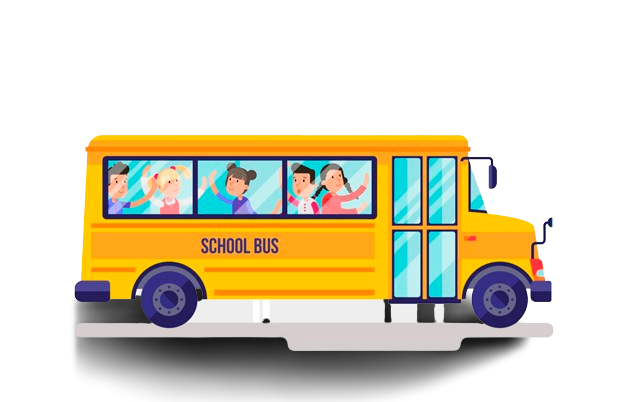
Transportation
We offer affordable transportation services that are safe and satisfactory for the adjoining area of the school.
Transportation rules:
Be Punctual: Students should arrive at the designated bus stop or pickup location on time. It is important to be ready and waiting, as the bus or transportation vehicle will adhere to a specific schedule.
Respect Others: Students should treat their fellow passengers, the driver, and transportation staff with respect and courtesy. Bullying, harassment, or disruptive behavior will not be tolerated.
Follow Instructions: Students must listen to and follow the instructions given by the driver or transportation staff. This includes where to sit, how to enter and exit the vehicle, and any safety-related guidelines.
Use Seat Belts (if available): If seat belts are provided on the transportation vehicle, students should wear them properly and keep them fastened throughout the journey.
Stay Seated and Face Forward: While the vehicle is in motion, students are expected to remain seated and face forward. Standing or moving around while the vehicle is moving poses a safety risk.
Keep Noise Level Reasonable: Excessive noise can be distracting to the driver and other passengers. Students should maintain a reasonable noise level and avoid shouting or making loud noises.
No Eating or Drinking: Eating or drinking on the transportation vehicle may be prohibited to maintain cleanliness and prevent allergic reactions among passengers. Students should follow any restrictions regarding food and beverages.
Keep the Vehicle Clean: Students are responsible for keeping the transportation vehicle clean and free from litter. They should dispose of any trash in the designated bins or containers provided.
Keep Personal Belongings Secure: Students should keep their belongings secure and not obstruct the aisles or emergency exits. Backpacks, bags, and other personal items should be stowed safely and out of the way.
No Vandalism or Damage: Students must not engage in any form of vandalism or damage to the transportation vehicle or its property. Any damage caused may result in disciplinary action and could incur costs for repairs.
Emergency Procedures: Students should familiarize themselves with the emergency procedures provided by the transportation staff. This includes knowing how to evacuate the vehicle safely in case of an emergency.
It is important for students and their parents or guardians to review and understand the specific transportation rules and guidelines established by their school or transportation provider. Compliance with these rules ensures a safe and efficient transportation experience for all students.
Transportation services in schools are essential for several reasons:
Accessibility: Transportation ensures that students have access to education, regardless of their distance from the school. It enables students who live far away or in areas with limited public transportation options to attend school regularly. This promotes inclusivity and equal educational opportunities for all students.
Safety: School transportation provides a safe and supervised mode of transportation for students. Buses and other school vehicles are operated by trained drivers who follow specific safety protocols. This reduces the risk of accidents and ensures that students are transported to and from school in a secure and controlled environment.
Time Management: Transportation services help students and their families manage their time effectively. By relying on designated school buses or transportation routes, students can arrive at school on time, avoiding potential delays and traffic congestion. This facilitates a smooth and organized start to the school day.
Reduced Traffic and Parking Issues: School transportation reduces the number of private vehicles on the road during peak school hours. This alleviates traffic congestion around school premises and nearby neighborhoods, making the commute safer and more efficient for all road users. It also minimizes parking challenges and the associated safety concerns.
Cost Savings: For families, utilizing school transportation can result in cost savings. It eliminates the need to own and maintain a personal vehicle solely for transporting children to and from school. This can be particularly beneficial for families with limited financial resources.
Environmental Impact: By encouraging students to use school transportation, schools contribute to reducing carbon emissions and environmental pollution. Instead of multiple individual vehicles, a single school bus can transport a larger number of students, resulting in a smaller carbon footprint and promoting sustainable transportation practices.
Community Building: School transportation often fosters a sense of community among students. Traveling together on buses allows students to interact with their peers from different grade levels, promoting social connections and friendships. It creates a shared experience and a sense of camaraderie among students attending the same school.
In summary, transportation services in schools ensure accessibility, safety, and time management for students and their families. They reduce traffic congestion, provide cost savings, and have a positive environmental impact. Additionally, school transportation contributes to community building and fosters social connections among students.
